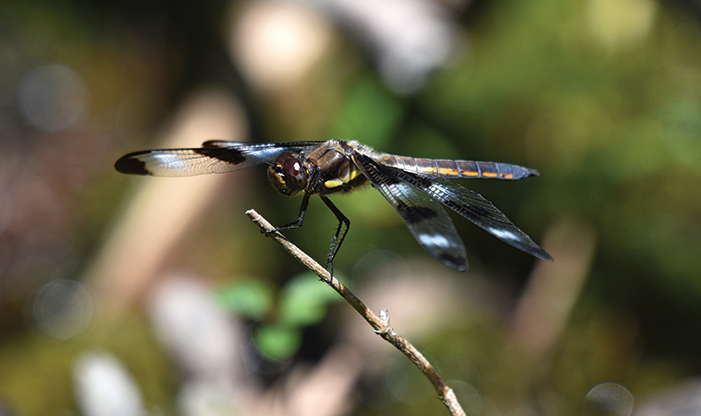Dragonflies are majestic in their beauty. The sheen of their iridescent bodies, their prominent, specialized wings, and their formidable flying style make them a wonder to observe. They are flying insects of the order Odonata, which includes both dragonflies and damselflies, displaying a remarkable range of diversity in behavior and appearance.
The Common Green Darner male has a grass green upper body with bright blue abdomen, while the Common Whitetail has a chalky white abdomen, dark face, and wide brown band across the center of their wing. The names of dragonfly species often reflect their unique qualities. Widow Skimmers skim over the water when they hunt, Prince Baskettails are named for how the female uses her tail like a basket to carry eggs, and a female from the Spiketail family has a spike-like ovipositor.
In Wisconsin, there are approximately 164 species of dragonfly and damselfly, with 6500 species occurring worldwide. Dragonflies can be distinguished from damselflies by how they hold their wings at rest. Damselflies hold their wings behind their back or outwards at a 45-degree angle, while the dragonfly’s four wings are stiff-looking, held straight out from both sides of the body.
Dragonflies are prolific at the Center. In one, three-hour survey looking for Odonates in 2018, we found 15 species. We are certain to find more species as we continue surveying. They live in all of our habitats, and include recently counted species like the Twelve-spotted Skimmer, which has three distinct black spots on each wing, and the Dot-tailed Whiteface, named for the telltale yellow dot on its rear segment and white spot on its face. Also seen on the property was the Blue Dasher, with pale blue abdomen and green and black striped thorax on the male.
The Aquatic Stage
Dragonflies are aquatic for most of their life. They live from one month to seven years as nymphs, depending on the species. Then, they spend only a fraction of their lives as flying adults. They live underwater in ponds, lakes, rivers, streams, and marshes. The six-legged dragonfly nymphs hunt and eat tadpoles, stonefly larva, snails, other dragonfly nymphs, and other invertebrates. They use their exceptional hinged lower jaw, called the labium, which acts like a third arm. The labium is sharply serrated, shooting forward to seize prey with moveable hooks on its front edge.
Emergence of Flight
Emergence is the highlight of dragonfly life, a turning point when the young nymph undergoes metamorphosis to become a very different creature. Newly emerged dragonflies are called tenerals, Latin for “tender” or “delicate.” When it emerges, it is soft with pale coloring and cannot fly well. Small, newly emerged tenerals take a half-hour to two hours before they fly. Then, they head to shelter in a woodland or grassy meadow, leaving behind their abandoned nymph skin, called an exuviae. It takes one to two weeks before they will become a sexually mature adult.
Continuing Their Lifecycle
The adult period of a dragonfly’s lifecycle is comparatively short, emerging to mate in either spring or summer. Adults head back to water to mate. Male dragonflies find territories that have high-quality habitat, with access to food, for females to lay eggs. The mating period includes two weeks to a month of intense activity. The female will likely mate several times, laying about 100 eggs at a time. Most eggs hatch in a couple of days, while some stay dormant until the next spring.
A newly hatched dragonfly is called a pronymph, which is featureless until it molts, or sheds its skin. Most North American species take 11 months to get through all of their molts, but it varies between species. Wandering Gliders become full size nymphs in 40 days, and are then ready to emerge, while the Clubtail Dragonhunter from the tropics takes five to seven years to emerge. The period between molts is dependent on resources like food availability and warmth.
Avid Hunters
Once in adulthood, dragonflies become agile hunters. They eat only live insects—whatever happens to be flying nearby—including deerflies, blackflies, horseflies, midges, and mosquitos. They also hunt beetles, flying ants, other dragonflies and winged insects. The amount they eat is massive, at least ten to fifteen percent of body weight per day, and sometimes much more.
Their hunting techniques include hawking or gleaning. To hawk, they will fly back and forth in the same area, scanning to catch insects with their mouth or legs. To glean, they will hover over a plant to see if an insect is there and catch it with its legs. They will also follow large animals, catching whatever they stir up.
The dragonfly pioneered its aerial feeding strategy 300 million years ago using the power of its aerodynamic wings. It flies non-stop on good, warm and sunny days, and they can hunt in swarms. Amazingly, their catch rate is 99 percent.
Dragonflies are the most agile of all flying insects, and are studied by NASA and the US military. They can lift twice their body weight and fly 25-35 mph over long distances. The female dragonfly is 40 percent flight muscle, while the adult male can be 60 percent flight muscle. Some of the aerial tricks they perform include taking off straight up, making unbanked turns, and hovering for up to a minute.
The Advantage of Many-Sided Sight
Another advantageous trait the dragonfly has for flying and hunting is its compound eye, which helps it hunt totally by sight. 80 percent of the dragonfly’s brain is used for visual processing. The eyes make up most of the head, and are comprised of ommatidia (facets). They possess 10,000 to 30,000 facets per eye. Each facet resolves a slightly different image with a different direction, allowing them to see in almost every direction simultaneously.
They have another powerful visual enhancement as well. While humans have three light-sensitive photoreceptor proteins called opsins that allow us to see in red, green, and blue, dragonflies have four to five, and sometimes more photoreceptors. This allows them to see in four, five, or more colors as well as UV light and polarized light. This helps them detect movement to see their prey in sunlight and in water bodies.
The dragonfly has a world of sight available to it that we as humans can’t even imagine. Their experience flying by ponds at the Center or through our forests must look completely different to them than to us. Nonetheless, they are spectacular to see. Stop by the Center to hike the trails and witness the spectacle of dragonfly life!


